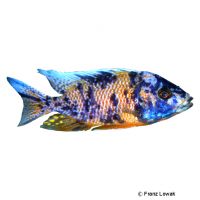Marmelade Cat Peacock (Aulonocara sp. 'Marmelade Cat')
| Marmelade Cat Peacock Aulonocara sp. 'Marmelade Cat' | |
|---|---|
| Name | Marmelade Cat Peacock |
| Name Lat. | Aulonocara sp. 'Marmelade Cat' |
| Family | Cichlids |
| Family lat. | Cichlidae |
| Order | Cichlids |
| Order lat. | Cichliformes |
| Origin | Lake Malawi (breeding variety) |
| Habitat | Intermediate zone |
| Diet | Carnivore |
| pH | 7.5-8.8 |
| Behavior | Semi-aggressive |
| Keeping | Harem |
| Care Level | Moderate |
| Reproduction | Mouthbrooder |
| Breeding | Simple |
| Life Span | 6-10 years |
| Protection | No |
| Metric Units | |
| Size | 12 cm |
| Temperature | 24-28 °C |
| Hardness | 10-25 °dH |
| Aquarium | ~ 300 l |
| US Units | |
| Size | 4.7" |
| Temperature | 75-82 °F |
| Hardness | 178-445 ppm |
| Aquarium | ~ 80 gal |
Distribution and habitat
The Marmalade Cat Aulonocara is a breeding form created by crossing an Aulonocara species with a pied color morph of Maylandia esthere (formerly Pseudotropheus esthere). The Aulonocara and Maylandia wild forms originate from Lake Malawi in Southeast Africa.
Maintenance
The aquarium setup should have rock structures that reach the water surface, with plenty of crevices, caves and shelters to provide hiding places, and a light-colored substrate with open sandy areas.
No ammonia, ammonium and nitrite should be detectable, the nitrate value should not exceed 100 mg/l. To ensure the water quality and the oxygen content, a filter adapted to the aquarium size and a heater are required, as well as lighting for the species-appropriate day-night rhythm of the animals.
Diet
In the wild they feed mainly on insect larvae and small crustaceans living in the sand. The food supply consists of live, frozen and dry food. For a balanced diet, feed once a day with a high-quality, protein-rich dry food for cichlids (flakes, granules, pellets) as well as daphnia, Artemia mysis, mosquito larvae, etc. (live or frozen).
It is recommended to feed small portions several times a day. Only feed as much as will be eaten within a few minutes. A regular and varied diet promotes health and increases resistance.
Behaviour and compatibility
They should be kept in a harem, one male with several females. Males among themselves behave territorially, so keeping several harems is only recommended in a larger and richly structured tank. With their calm temperament they belong to the more peaceful Malawi cichlids and should only be socialized with other peaceful cichlids.
Basically, only compatible fish species with similar demands on water conditions and water temperature should be socialized.
Sex dimorphism
The male is more colorful than the female (sexual dichromatism) and has longer, more pointed fins. The female is usually smaller and not so brightly colored
Reproduction and breeding
They are maternal mouth brooders. Immediately after spawning on a rock, the females take the eggs into their throat sac for mouth brooding. They retain the fry in their throat sac even after hatching. After about 4 weeks, the fry are released and brood care ends. During the entire brood care, the female does not take any food.
Fry must be fed several times a day with special rearing food. In a community tank breeding is hardly possible, because the fry are easy prey.
Important
The Marmalade Cat Aulonocaras belong to the so-called OB morph, in which both sexes are pied. There are numerous color morphs, such as light blue, yellow, purple, red, orange-red etc., which are offered by breeders with fanciful names
They should not be kept in the same tank with other Aulonocara species, as they may interbreed.
The well-being of the fish should be checked regularly. Temperature should be checked daily, pH, hardness and nitrate levels at least every 14 days. Regular partial water changes are recommended, even if the contaminant level has not yet reached the upper limit. Sudden changes in water quality should be avoided. Newly introduced fish must be accustomed slowly to the water in the aquarium.
Further literature can be found in your pet store.
References
Text: Werner Winter; Image: Franz Lowak
Source: BMELV (1998): Tierschutzgutachten - Haltung von Zierfischen (Süßwasser); ENGELMANN (2005): Zootierhaltung - Tiere in menschlicher Obhut: Fische, Verlag Harri Deutsch
- Gemäß § 21 Abs. 5 Tierschutzgesetz idgF
